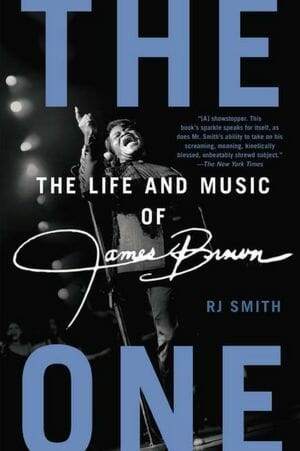The One: The Life and Music of James Brown by RJ Smith
Payin’ The Cost To Be The Boss

James Brown, who died in 2006, enjoys membership in a very exclusive club of musicians, a group of men and women who created the current landscape of pop music.
A driven singer who labored furiously at his art, Brown pushed soul, invented funk and laid the groundwork for the subsequent musical juggernauts disco and hip-hop. He created his own myth, following a practically monomaniacal obsession to be the best, the most powerful, the most explosive, the funkiest, the equal of presidents and dictators, a man above and beyond the law.
For a period, he managed to be most of these things. In The One: The Life And Music Of James Brown, Brown’s biographer RJ Smith, who has written and edited for LA Magazine, Spin and the Village Voice, presents the myth of James Brown in all its contradictory power. He also allows us to see the man and the music inside the myth.
James Brown funk blew open the sound of pop in the second half of the ‘60s (Smith looks into the origin of the word funk; it might relate to sex, the broke-musician lifestyle, or some term in Flemish). One of Brown’s biggest innovations, also linking to the title of Smith’s book, involved moving the rhythm’s emphasis from the second and fourth beats of a measure—the standard established by blues—to the first beat. The tremendous spring Brown then launched on the initial beat caught listeners off-guard and compelled movement. It also gave Brown flexibility in his live performances to change the band’s direction on that first beat, and it provided the musicians with an anchor for sensing their positions as they whipped up a furious storm of funk. Smith notes that the big One allowed Brown’s “audience to stay with him. . . it is the cash upfront he pays for all the rhythm it buys.”
And Brown bought a ton of rhythm, stripping almost every instrument down to its rhythmic bare bones, minimizing melodic elements. Smith quotes the musicologist Robert Palmer (this exact quote also comes up in author Peter Guralnick’s chapter on Brown from the famous book Sweet Soul Music): “The rhythmic elements became the song. There were few chord changes, or none at all, but there were plenty of trick rhythmic interludes and suspensions. . . Brown and his musicians began to treat every instrument and voice in the group as if it were a drum.” Brown thus dispensed with tradition, caution and “… dazzling display of technique … he wanted a mass of people dancing.”
He took an unconventional approach towards songwriting. As Smith puts it, “Brown was something rarer than a great musician: He knew when the bad note was the right one.” In an interview with the magazine DownBeat, Fred Wesley, who played trombone with Brown, described the creative process similarly—“‘James didn’t understand how to do it musically, so we had to do it his way. And his way was just hit and quit it. . . Forced music. We just forced it to work. It got to be easy to force it to work after a while because you knew that it was unorthodox, unheard of, so you just made it work.’”
Brown ultimately forced his music to something edgier, more syncopated and thrilling, the type of thing embodied in songs like “Get Up (I Feel Like Being A) Sex Machine,” “You Got To Have A Mother For Me,” and “Superbad.” The guitars delivered precise doses of needle-sharp riffing, as if hammering through a wall, or issued quick, explosive bursts of notes that cracked off as soon as they seemed to start. The bass lines came big and brutal but short, chained down, circling over the same territory again and again like they were trying to figure out a way to escape their own rigidity. The brass landed with a thick, unconstrained power, a model of tactical efficiency and synchronization, battering the same location again and again, splitting off for splintered, staccato attacks, occasionally whirling off into complete madness. Brown perfected this style, and between 1969 and 1971, 17 of his songs cracked the top 10 on the R&B charts. Those years brought him worldwide fame.
Brown’s commercial success also stemmed in part from his ability to manipulate the musical marketplace. He famously gave DJs money to promote his records. (Brown might refer to this as “payin’ the cost to be the boss,” a lyric from his Black Caesar album.) He pumped up ticket sales for his shows by leaking rumors that he planned to retire, or that he suffered from health problems. Later he bought radio stations of his own to cut out the middleman. In 1966, Brown signed a new record contract that took complete control of the rights to his music and also gave him the ability to sign singers to his label … a stunning success for a black artist.
-

-

-

-

-

-

-

-

-

-

-

-

-

-

-

-

-

-

-

-

-

-

-

-

-

-

-

-

-

-

-

-

-

-

-

-

-

-

-

-








































